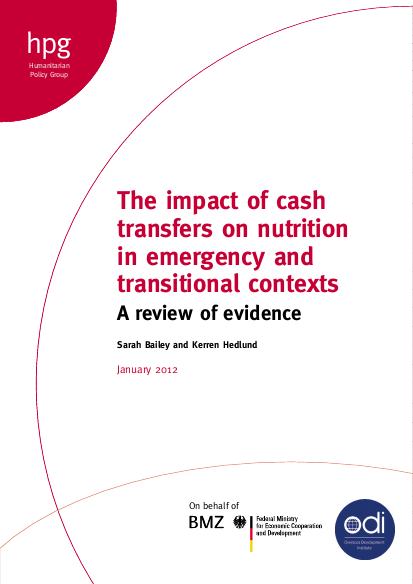
Cash transfer programming is now widely accepted as a way to meet a variety of needs in humanitarian and transitional settings.1 Where appropriate, cash enables people to buy goods and services according to their own priorities, and supports markets. Although the literature on cash transfers has grown exponentially over the last few years, as has their use in humanitarian interventions, the relationship between cash transfer interventions in crisis contexts and malnutrition has received little attention. This is surprising given that many cash transfers have nutritional objectives, such as improving access to an adequate quantity and quality of food. One reason for this may be that food security and nutrition tend to exist as separate sectors within emergency and transitional operations, though several agencies are now working on better linking the two (Levine and Chastre, 2011). Nutrition, food security and health actors all could consider cash transfers as a way of addressing the multiple causes of malnutrition. This leads to a series of important questions. How far can cash responses go in addressing malnutrition? What can we reasonably expect them to achieve? Given the many cash responses to date, what do we know (and not know) about their impact on malnutrition? The purpose of this paper is to explore evidence on the nutritional impact of cash transfers in emergency and transitional settings. It has been commissioned by the German government (Federal Ministry for Economic Cooperation and Development BMZ) through the Deutsche Gesellschaft für Internationale Zusammenarbeit (GIZ). It builds on previous cooperation between BMZ and the Humanitarian Policy Group at the Overseas Development Institute, which resulted in the paper Food Aid and Food Assistance in Emergency and Transitional Contexts: A Review of Current Thinking. Two priorities identified by the paper are particularly relevant to this study: the need to expand the use of cash as a food assistance tool, and the importance of considering the nutritional outcomes of food assistance (Harvey et al., 2010). Analysing the impact of cash transfer programming on nutrition is a complex task. The biggest challenge is evidence. Ideally this paper would draw from robust research from different interventions showing that cash did or did not have a positive impact on nutrition outcomes (e.g. anthropometric indicators, micronutrient deficiencies), and why. However, such evidence is not available in these settings, at least not yet. Attributing nutritional impact to humanitarian interventions is notoriously difficult in general (Hall et al., 2011; SCUK, 2009; Dunn, 2010; Shoham, 2004).2 In addition, cash transfers are mostly used to address food and other basic needs and rarely have the explicit objective of improving nutrition; as a result, these interventions have not commonly monitored changes in nutritional status. Research is planned on the impact of different types of food assistance (e.g. food aid, cash transfers and vouchers) on nutrition, as well as comparing cash with more traditional interventions to address moderate acute malnutrition (e.g. supplementary feeding programmes), but generating findings will take time.